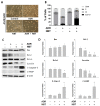Nobiletin Enhances Chemosensitivity to Adriamycin through Modulation of the Akt/GSK3β/β⁻Catenin/MYCN/MRP1 Signaling Pathway in A549 Human Non-Small-Cell Lung Cancer Cells
- PMID: 30486290
- PMCID: PMC6316077
- DOI: 10.3390/nu10121829
Nobiletin Enhances Chemosensitivity to Adriamycin through Modulation of the Akt/GSK3β/β⁻Catenin/MYCN/MRP1 Signaling Pathway in A549 Human Non-Small-Cell Lung Cancer Cells
Abstract
Drug resistance is a major problem in the treatment of non-small-cell lung cancer (NSCLC). In this study, Kyoto Encyclopedia of Genes and Genomes (KEGG) pathway analysis was performed to identify the differentially expressed genes in Adriamycin (ADR)-resistant NSCLC A549/ADR cells compared with parental A549 cells. Among the tested phytochemicals, nobiletin (NBT) is able to overcome the ADR resistance of A549/ADR cells. NBT treatment decreased the expression of a neuroblastoma-derived MYC (MYCN) and multidrug resistance-associated protein 1 (MRP1) as well as downregulating Akt, GSK3β, and β-catenin. Consistent with these results, NBT treatment resulted in the accumulation of intracellular ADR. A combination index (CI) assay confirmed the synergistic effect of combined treatment with NBT and ADR in reducing the viability of A549/ADR cells (CI = 0.152). Combined treatment with NBT and ADR enhanced apoptosis in A549/ADR cells, as evidenced by increased caspase-3 activation, poly (ADP-ribose) polymerase (PARP) cleavage, and sub-G1 population compared to treatment with ADR alone. In vivo experiments using a mouse xenograft model revealed that combination therapy with NBT and ADR significantly reduced tumor volume by 84.15%. These data suggest that NBT can sensitize ADR-induced cytotoxicity against A549/ADR cells by inhibiting MRP1 expression, indicating that NBT could serve as an effective adjuvant agent for ADR-based chemotherapy in lung cancer.
Keywords: A549 human non-small-cell lung cancer cells; Adriamycin (ADR); multidrug resistance-associated protein 1 (MRP1); nobiletin (NBT).
Conflict of interest statement
The authors declare no conflict of interest.
Figures








Similar articles
-
Nootkatone, an AMPK activator derived from grapefruit, inhibits KRAS downstream pathway and sensitizes non-small-cell lung cancer A549 cells to adriamycin.Phytomedicine. 2019 Oct;63:153000. doi: 10.1016/j.phymed.2019.153000. Epub 2019 Jun 27. Phytomedicine. 2019. PMID: 31280139
-
Effects of the Combination of Gliotoxin and Adriamycin on the Adriamycin-Resistant Non-Small-Cell Lung Cancer A549 Cell Line.Mar Drugs. 2018 Mar 27;16(4):105. doi: 10.3390/md16040105. Mar Drugs. 2018. PMID: 29584673 Free PMC article.
-
Synergistic antitumor effect of a combination of paclitaxel and carboplatin with nobiletin from Citrus depressa on non-small-cell lung cancer cell lines.Planta Med. 2014 Apr;80(6):452-7. doi: 10.1055/s-0034-1368321. Epub 2014 Mar 31. Planta Med. 2014. PMID: 24687742
-
Recent advances in the therapeutic potential of nobiletin against respiratory diseases.Phytomedicine. 2024 Jun;128:155506. doi: 10.1016/j.phymed.2024.155506. Epub 2024 Mar 1. Phytomedicine. 2024. PMID: 38522319 Review.
-
Nobiletin in Cancer Therapy; Mechanisms and Therapy Perspectives.Curr Pharm Des. 2023;29(22):1713-1728. doi: 10.2174/1381612829666230426115424. Curr Pharm Des. 2023. PMID: 37185325 Review.
Cited by
-
Characterization of chemoresistant human non-small cell lung cancer cells by metabolic and lipidomic profiling.Metabolomics. 2023 Sep 10;19(9):80. doi: 10.1007/s11306-023-02045-3. Metabolomics. 2023. PMID: 37690093
-
Dietary flavonoid myricetin inhibits invasion and migration of radioresistant lung cancer cells (A549-IR) by suppressing MMP-2 and MMP-9 expressions through inhibition of the FAK-ERK signaling pathway.Food Sci Nutr. 2020 Mar 9;8(4):2059-2067. doi: 10.1002/fsn3.1495. eCollection 2020 Apr. Food Sci Nutr. 2020. PMID: 32328272 Free PMC article.
-
Prognosis and personalized treatment prediction in lung adenocarcinoma: An in silico and in vitro strategy adopting cuproptosis related lncRNA towards precision oncology.Front Pharmacol. 2023 Feb 15;14:1113808. doi: 10.3389/fphar.2023.1113808. eCollection 2023. Front Pharmacol. 2023. PMID: 36874011 Free PMC article.
-
Baicalein Suppresses Stem Cell-Like Characteristics in Radio- and Chemoresistant MDA-MB-231 Human Breast Cancer Cells through Up-Regulation of IFIT2.Nutrients. 2019 Mar 14;11(3):624. doi: 10.3390/nu11030624. Nutrients. 2019. PMID: 30875792 Free PMC article.
-
Flavonoids: A Myth or a Reality for Cancer Therapy?Molecules. 2021 Jun 11;26(12):3583. doi: 10.3390/molecules26123583. Molecules. 2021. PMID: 34208196 Free PMC article. Review.
References
-
- Ferlay J., Soerjomataram I., Ervik M., Dikshit R., Eser S., Mathers C., Rebelo M., Parkin D., Forman D., Bray F. Cancer Incidence and Mortality Worldwide: Iarc Cancer Base no. 11. International Agency for Research on Cancer; Paris, France: 2013.
MeSH terms
Substances
Grants and funding
LinkOut - more resources
Full Text Sources
Medical
Research Materials
Miscellaneous

